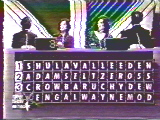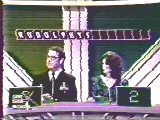Now You See It
From RulesWiki
| NOW YOU SEE IT | |
| The 1974-1975 logo of 'Now You See It'. | |
|---|---|
| Airdates: | CBS April 1974 - June 1975, CBS April 1989 - June 1989 |
| Hosts: | Jack Narz, Chuck Henry |
| Announcers: | Johnny Olson, Gene Wood, Mark Driscoll, Don Morrow |
| Producer: | Mark Goodson-Bill Todman Productions (1974-5), Mark Goodson Productions (1989) |
Contents |
Gameplay
1974-1975 version
Front Game (version one)
A total of five contestants competed, one either a returning champion or designated champion by random draw. The remaining four players are paired up to play the opening round. One member of each team faces a board consisting of four lines, each row with 14 letters reading across. The other two players sit facing away from the board. The host reads a clue to a word located on the board, reading left to right. The first player to locate the word buzzes in and announces the line. If correct, his/her teammate then turns around to find the word, then gives its starting position and the answer. If correct, the team scores the number of points equal to the row number plus the starting position. (Thus, a word found on row 2, position 7 scores 9 points.) This board is played for three minutes, at which point a bell rings and the team members switch positions. After two rounds, the team with the highest score advances to the semifinals.After the first week, players were given a moment to study the board and write down one of the words they found. If that word was used as an answer to a clue, they would score an additional 10 points.
In the semifinals, the teammates competed against one another in a race to guess four words correctly. Starting at the first line, the host would again read a clue, at which point the answer would be spelled out, letter by letter, until either one of the players chimed in and answered correctly or all but the last letter had been exposed. The end of each word would then be used as the start of the next word, although players were not told where exactly the word started. The first player to find four words advanced to the championship round.In the championship round, the winner of the semifinals played against the day's champion. The game was played in the same fashion as the opening round, except that players were responsible for getting both the row and the position. This game was played for three minutes as before; the highest scoring player advanced to the Solo Round.
Front Game (version two)
Toward the end of the show's first run, the first round was dropped and two new contestants competed for the right to face the champion. The first round was played in the same fashion as the semifinals above. The first player to find five words won the game and advanced to the Championship Round.
The championship round was played as before, except now the aim was to be the first player to score 100 points. Scoring was the same as the original version, however point values doubled once one of the players had score 50 points. The first to reach 100 points won the game and went on to the Solo Round.
End Game ("Solo Round")
The winning player now had 60 seconds to find ten answers on a board of 4 rows, 16 letters each. Players viewed the board on a television monitor, using a telestrator-like light pen to circle the words. Each word that was found won $100; finding all ten won a jackpot that started at $5000 and increased by $1000 each day it wasn't won. If a player won the Solo Round, s/he retired undefeated; otherwise, s/he returned the next day as the champion, for a maximum of five days.
1989 version
The opening round is played between two new players. A board of 4 rows, 14 letters across was presented to the players. The host then asked a question, the answer to which was located somewhere on the board. If a player managed to find the answer right away, s/he scored 100 points; otherwise, the value of the question went down 5 points for each third of a second it took to find the answer. If five seconds elapsed with neither player buzzing in, the host would then give the row where the answer was found. Two boards were played, and point values doubled when time was running short. The first player to score 1000 points won the round and advanced to the championship round.In the championship round, the winner of the first round competed against the previous day's champion, or a designated champion if all three players were new. The players were shown another board, containing six words fitting a certain subject. The first player to buzz in and name one of the words was given control of the board, and had 20 seconds to find the other five answers. During this time, the other player was unable to see the board. If any words were left unidentified after 20 seconds, the other player would then have five seconds to find one of the words remaining and steal the board. The first board was worth $200; subsequent boards were each worth $100 more than the last. The first player to reach $1000 won the game, got to keep the money, and advanced to the Solo Round. The Solo Round was played in exactly the same fashion as the original version; finding ten words in 60 seconds or less won a jackpot that started at $5000 and increased by $5000 each day it went unclaimed. Champions stayed on the show a maximum of five days or until they surpassed the network's limit of $50,000 in winnings.
Notes
- Oftentimes in the 1974-1975 version, the board used to show the title in the opening word would conceal the words LINE, CLOCK, TRUTH, TATTLE, PRICE, MATCH, and PASSWORD - all of which are references to other Goodson-Todman game shows.






